Fire sticks, or feather sticks as they are also called, are a great survival tool when you’re out in the wilderness.
In a survival situation, you want to be able to make not only a quick-starting fire, but a sustainable one to keep you warm throughout the night. Both frostbite and hypothermia can set in far more rapidly than many folks think.
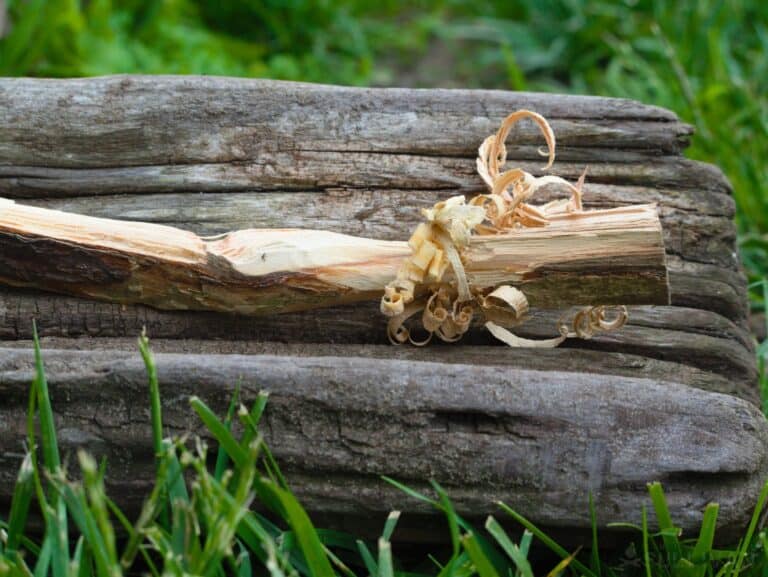
Many campers can master this skill with a bit of practice as well as it’s a great way to show off building a fire in wet conditions. But why?
Table of Contents
Why Would You Want To Make a Feather Stick?
With so many fire starters on the market one might ask why you would need a feather stick to begin with. There are a number of reasons why, including:
- It already exists out in the woods, no need to bring anything in with you
- Helps you practice your knife skills for other projects
- You might not have anything with you in a survival situation
- If you run out of firestarter on your trip then a feather stick makes for a great alternative.
With a lot of practice, a fire stick will help your bundle of tinder not only catch a flame quickly, but will build the fire up with sustainable heat in a shorter amount of time than with tinder alone – especially if dealing with damp fire starters or logs.
The resources you need to make a traditional feather stick are few – just a stick and a nice sharp knife. Getting the perfect feathered ends on a fire stick takes some skill, but with some practice and patience anyone can make one in a short time.
How Feather Sticks Work
It is the body of the stick and not the feathers attached to it that create the fuel for a flame. The more fine the stick, the quicker an ignition point it will prompt.
The feather-like shavings on the stick should be both fine and long. You want to create as dense a grouping of feathers as possible to help grow the flame you will be starting.
Simply tossing a bunch of shavings or fire starter into a sparked flame will not help to ignite and sustain it as well as the feather stick can. Such shavings or fire starters can pile up or blow away to some degree, if you are attempting to get flames going in damp or wining conditions.
Because the shavings or curled feathers on the feather stick are still attached, they are elevated from the ground and far less prone to become damp or outright wet due to snow or rain.
Feather sticks can be moved around to “chase” a flame – neither loose shavings or fire starters can be used in this same advantageous manner. Being able to move the stick around so all of the tinder will catch, is yet another advantage of using this bushcraft fire-starting tool.
Because the feathers are still attached to the stick, moving them about in the young fire makes them serve as a type of bellow – putting more oxygen into the fire where it needs it and none where it does not.
Why Feathersticks Are a Valuable Survival Tool
A feather stick serves as both a fire starter and tinder. These sticks are tasked with one extremely important job, quickly generating your initial heat fuel source. They are thinner than traditional kindling, and they can get flames to catch more rapidly, when used properly.
Sure, fire starters can help spark a flame quickly also, but even though they are handy to keep in a bug-out bag, they simply are not as good at growing and maintaining a flame as a feather stick. How To Make Feather Sticks
Materials
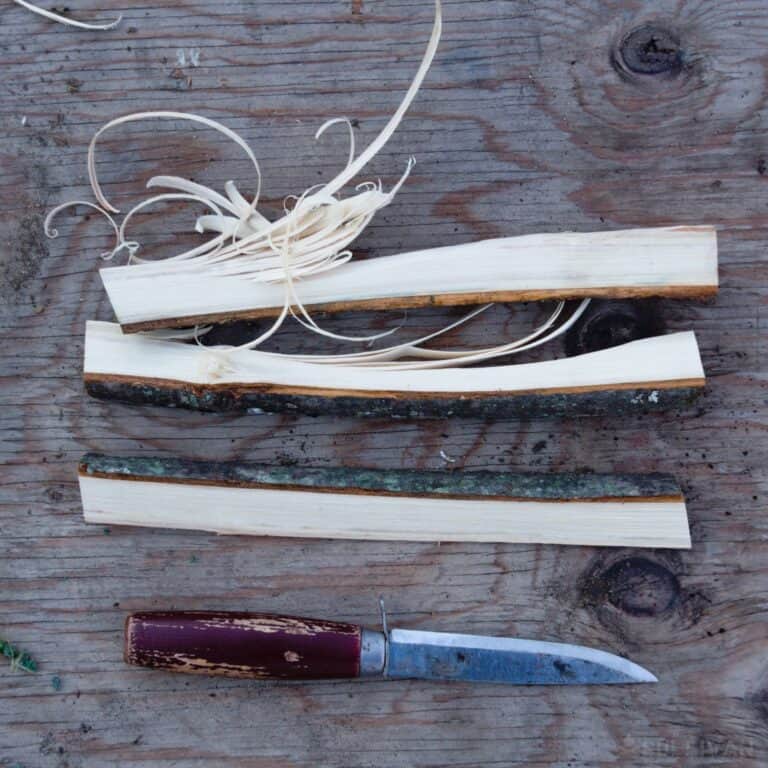
- Sharp knife – one with a non-serrated knife edge seems to work best. A grippy handle provides the stability to keep the blade straight when creating the feathers.
- Dry wood from a stick of firewood or a dead branch from a tree that is not touching the ground. Ideally, the branch should be between 12 to 14 inches long (about 35 cm) and not too large in diameter. Avoid using wood that has a knot in it. It can catch the blade and make it difficult to shave. A straight grain is preferred for nice long strips.
- Working with knives can be dangerous. Use leather work gloves.
- Hammer – optional. Some fire stick makers use the hammer to pound the angled knife so they can both scrape and chisel into the wood to create the start of the feathered ends.
How To Make Feather Sticks Step by Step
Step 1. It’s important to make sure that your wood or branch is straight and knot-free. If you’re using dead standing wood make sure to baton it with your knife.
Batoning means to split the log into quarters or smaller. Remember to try and keep your feather sticks long, at least 30cm long and maximum 2 inches in diameter.
Step 2. Make sure the piece of wood you intend to use as a feather stick is set on a flat surface. You don’t want your knife cuts to move the wood while you work with it.
It’s best if you kneel down with the wood angled in front of you, the butt end of the piece on the ground:
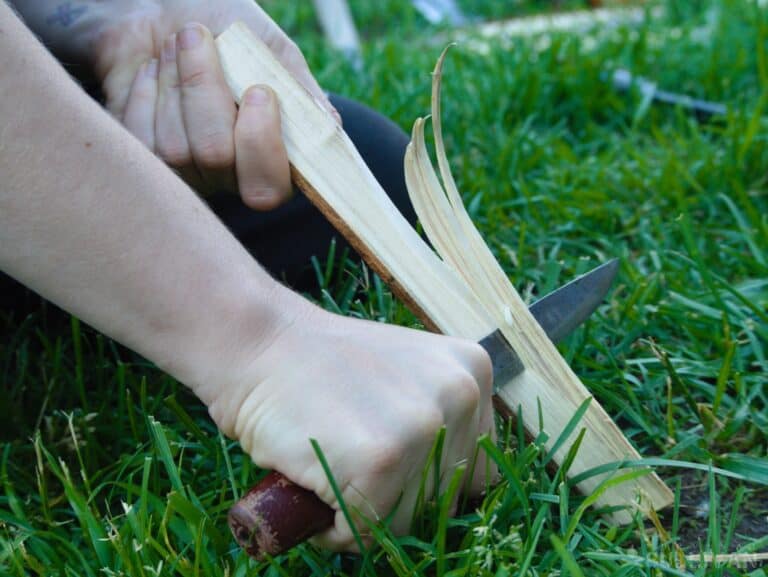
Keep the handle of the knife as close to the branch or fire wood as possible, and keep the tip of the knife angled so it protrudes on the far side of the fire stick source, as possible.
Step 3. Hold the knife at a horizontal angle at the top of the branch batoned wood.
Keep the handle of the knife as close to the branch or fire wood as possible, and keep the tip of the knife angled so it protrudes on the far side of the fire stick source.
You want to ensure that part of the blade by the handle makes as much contact with the wood as possible.
Step 4. At a straight downward angle, shave small strips, leaving on the curly feather type end. You must stop before reaching the very end of the strip of wood to garner the feather effect.
It’s imperative that you keep the angle of the blade inward. A blade that is at a 90-degree angle won’t be effective.
Step 5. You may notice that you aren’t making the best curls right away and this is okay. It’s important to build a foundation upon which your curls will sit without falling off. Your goal is to essentially plane the piece of wood at the start.
Choose the inside sharp edge of the wood to create longer curls. As you push the knife downward make sure to angle it inwards the smallest amount to get those initial long curls.
Step 6. Once you’ve flattened the sharp edge enough you can just continue the process, but focusing on shaving thicker curls. Use the straightest part of the knife here and keep the pressure consistent as you drive the blade downward.
Step 7. If some of the curls fall off the stick as you begin you can still use them to start your fire. The biggest issue beginners have is keeping the wood straight and applying enough pressure to get longer curls.
Safety Tips
The knife should be turned inwards to ensure the edge is facing the branch or wood. Getting the blade to lay as flat as possible against the wood is essential – this is best achieved when using a flat beveled knife. Make sure the blade stays attached to the wood at all times.
If you ever curled a gift wrap ribbon with scissors to make it more attractive and to leave a curly end, you have practiced feather stick making, but just did not know it.
If you’ve ever done any kind of wood carving, making a feather stick should be easy as well.
Feather Stick-Making Tricks
Any type of dry or deadwood will work, but attempt to use a soft wood like sweet chestnut, pine, birch, or willow to get the fire to take off more quickly.
You will also find softwood far easier to carve or shave, than hardwood like oak, hickory, or locust.
The curls should be as close to each-other as possible, but doing this will become more difficult as the bottom of your branch or stick becomes full.
Once the spot you are working on becomes overcrowded with feathers, turn the wood so you can start shaving it on another side and create feathers around the bulk of the branch or fire wood.
If you accidentally knock off the curls at the end of your feather stick that’s okay! You can always lay them in your tinder pile and use them to start the fire you’re working on. A pile of shavings will still light, so keep them.
The thinness of the knife shouldn’t really matter when you’re making curls for your feather stick. As long as the blade is razor sharp and held at the right angle, even a small knife will get the job done.
Depending on the angle of the knife you can get thick curls or thin curls. A steeper angle gets you thicker curls while a shallow angle gives you smaller, thinner ones. Smaller curls are great for catching a spark while the bigger ones can get the fire going.
You can use a small hatchet or bush axes to make a feather stick. Ensure that it is sharpened enough to create shavings. Simply grab the axe by the head and gently scrape the curls down the piece of wood.
How to Use A Feather Stick
Carrying about 10 sticks in your bug-out bag should be enough to get a solid fire going in mere moments.
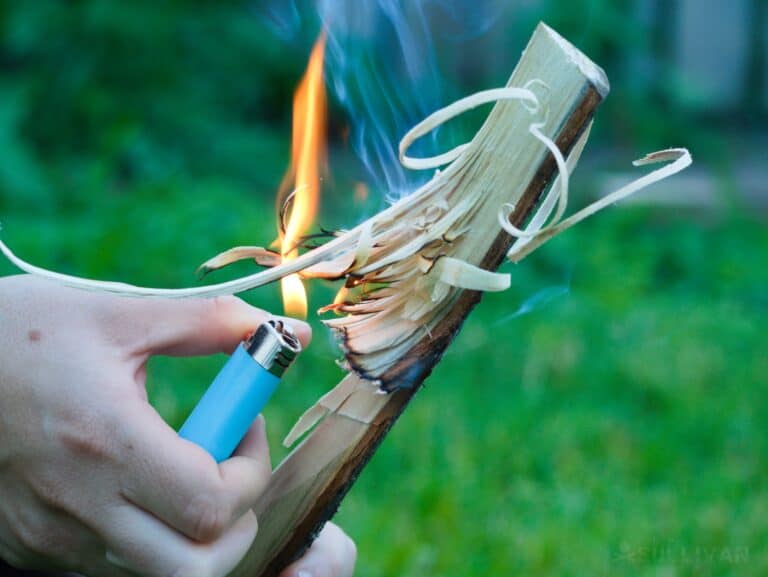
- Use a lighter to ignite the feathered end of the stick.
- Use the now burning feather sticks to light the tinder for your fire
- Lay the burning tinder into your fire, Do this carefully so you do not extinguish the tiny flame.
- Place several pieces of kindling on top of the tinder and fire stick that are resting in the fire ring.
- As the flames on the tinder spread and ignite the kindling, cradle the fire carefully with your hands (keep you hands a few inches away from the flames) to prevent even a slight wind from blowing them out.
- In just a couple of minutes, the fledgling fire should grow into steady flames that are now more wind resistant.
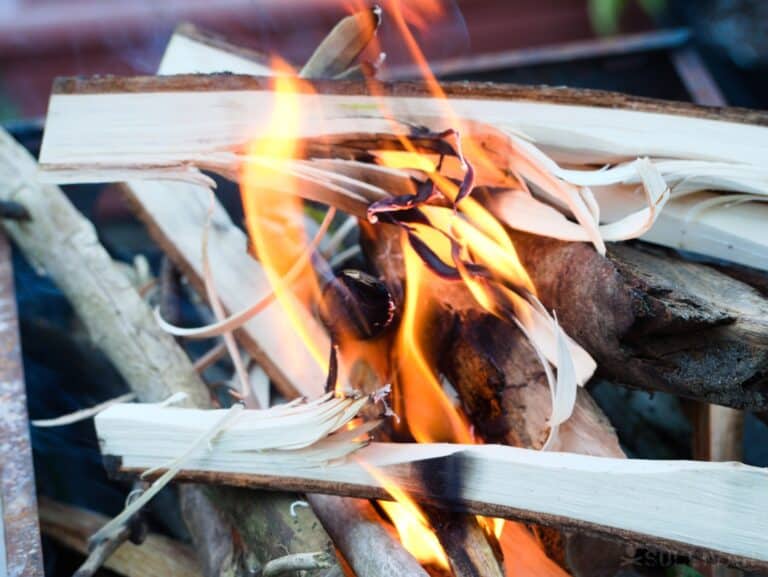
Remain tending to the fire as you carefully add more kindling to ensure you do not stifle the flames, but maintain or grow the fire to a level that makes it sustainable enough to add firewood, and stoke it so the heat begins to flow at a steady pace.
What Wood Makes The Best Feather Sticks?
Fatwood makes an excellent resource for feather sticks for your campfire and it is not a difficult task to find it. Small shavings filled with resin can be shaved off and ignited. The fatwood feather stick provides intense heat and is a great trick for making better feather sticks.
While you can use almost any species of tree to make a feather stick, there are some that work better than most. Always look for dry, dead wood. Damp wood will make a feather stick that will light poorly.
Pine
Pine wood makes excellent feather sticks as they are the trees that fatwood comes from. Any of the resin producing coniferous trees can start a fire even in the rainiest conditions.
Cedar
Cedar is a great wood for feather sticks because of its lightweight, straight wood. The night thing about cedar is that it burns hot and quick. If you want to get a fire started fast, this is a great wood to use. It is also water resistance and rot resistant which makes it a reliable source of fuel.
Willow
Willow is a soft wood that is easy to get long strokes with. Long pieces of willow and a sharp knife can produce long curls right to the end of the stick. It’s another lightweight wood that burns hot.
Feather sticks that are made from the branches of dead standing wood are the best to keep an eye out for.
You want the dry wood with a solid grain to get the thinnest possible shavings. The dead twigs from hard woods are also another great resource for making effective feather sticks.
Safety Tips
You have to be careful with any outdoor project, especially those involving knives or other sharp tools. Here are some useful tips for when you create your own feather sticks.
- Never shave a feather stick with the knife blade pointing towards you. All it takes is a little too much pressure and that harp blade can come right back up at you.
- Ensure you know where your hands are at all times. Sometimes sticks can slip while you’re feathering them and your knife can cut your finger, something you don’t need out in the bush.
- If you’re wary of splinters then put on some work gloves. Not only will it protect you from wooden shards it’ll also keep your hands a little cleaner afterward.
- When in doubt, always angle the piece of wood and the knife away from you. Don’t try to prop the stick up against your leg and whittle away because the knife might end up in your leg.
- Don’t try to make a feather stick using the tip of your knife. The knife could flick out and hit the ground or your foot if you’re not careful.
- Using the back of the blade on your knife won’t be effective in making feather sticks but it could inadvertently injure you as the blade is now facing upwards.
3 Good Knives For Making Feather Sticks
Finding the right piece of wood for a feather stick is only half the battle. Having a low-quality blade will make this task harder and give you less than the desired results.
Using something like a swiss army knife may do the job but it’s not the best tool for the job as it doesn’t offer much control. Here are the best knives for making feather sticks in the backcountry.
Disclosure: This post has links to 3rd party websites, so I may get a commission if you buy through those links. Survival Sullivan is a participant in the Amazon Services LLC Associates Program. As an Amazon Associate, I earn from qualifying purchases. See my full disclosure for more.
Morakniv Companion
| Pros | Cons |
|---|---|
| Ergonomic design is a life saver Affordable Easy to sharpen Stainless steel blade | Not a full tang Blade sheathe feels kind of cheap |
Mora is known for making affordable blades that are well crafted and durable. They are one of the go-to brands for outdoorsmen.
This is a simple knife that can do small chores, one of which being feather sticks for the fire.
Cold Steel SRK SK-5
| Pros | Cons |
|---|---|
| Thicker blade feels durable Used by special forces Made with Japanese high carbon steel | Little bit expensive for a simple knife Overall a lighter knife |
Another standard backup knife or beginner knife is the Cold Steel SRK knife. It is a simple tool that is designed to cut well with minimal maintenance.
If you’re looking for something that can do some lightweight feather stick making, this is the knife you want to check out.
Ontario Knife 6525 Bushcraft Field Knife
| Pros | Cons |
|---|---|
| Full tang Satin finish spear pointed blade Stainless steel | Pricey |
Full tang makes for increased stability in your knife. More stability means that making those feather sticks suddenly becomes an easier task. The tip of the knife is a spear point and the high-quality steel will make quick shavings out of any wood type.
Frequently Asked Questions
Not every piece of wood will work well for making a feather stick. The best wood to look for is dry, dead standing trees. These are up off the ground so they have minimal moisture penetration.
You want wood that is small enough to baton easily enough with your knife. Look for a straight edge with no knots as they will impact how you shave the wood.
The best woods for making feather sticks are willow, pine, and cedar.
Resinous wood will catch a flame really well so keep an eye out for any fatwood that you can use.
Many avid survivalists have many ways to create a spark to start a fire. Feather sticks are made from dry wood that is curled into thin strips. These are able to take a flame very easily and luckily there are lots of ways to get it started.
If you are one to carry a lighter out with you, then this is by far the easiest way to get the process started. Once your feather stick curls have caught the flame and are ablaze, feel free to light different sides of your fire and then put the feather stick in the middle.
If your curls are fine enough you can easily get the fire started with your ferro rod. This method might be easier if you push the curls off the feather stick and have them arranged in a neat pile in the middle of your fire pit.
Simply place your ferro rod inside the bundle of shavings you made, and pull it back against the striker. This will send a shower of sparks onto the pile without you disturbing it by accidentally hitting it with the striker.
Yes, you can make a feather stick out of wet wood since it’ll still curl when your knife passes over it. However, depending on the thickness of the curls you might have an issue trying to start it.
If you’re using a BIC lighter then it’ll have to dry the curls out. Once they’re dry the feather stick will light but if won’t progress down the stick since it is still wet.
Trying to start a feather stick with a ferro rod while it’s wet will be a problem as well since the sparks will have a hard time igniting the curls you made.
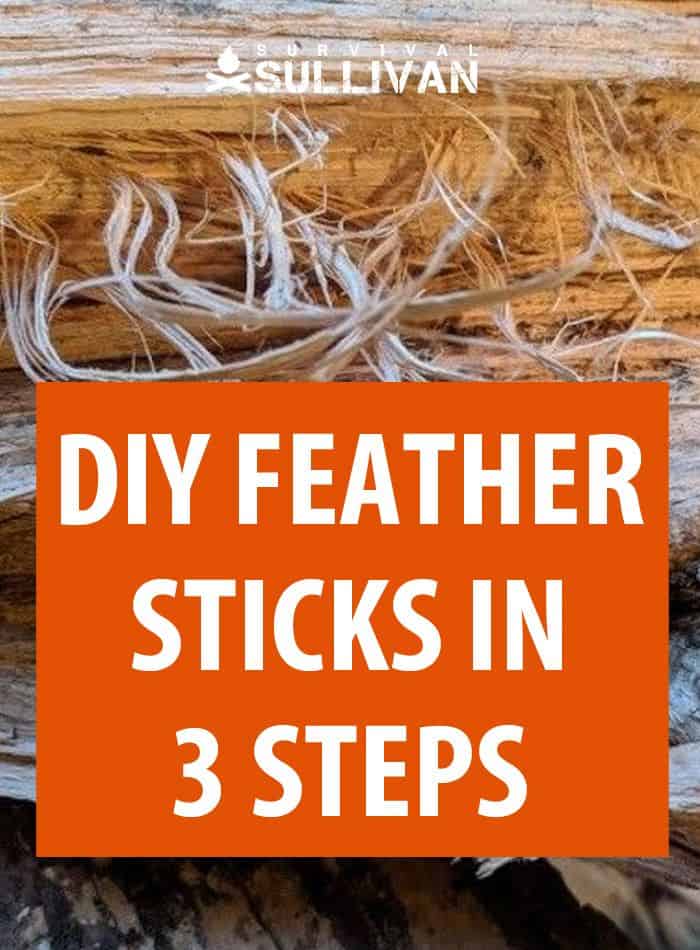

Tara Dodrill is a homesteading and survival journalist and author. She lives on a small ranch with her family in Appalachia. She has been both a host and frequent guest on preparedness radio shows. In addition to the publication of her first book, ‘Power Grid Down: How to Prepare, Survive, and Thrive after the Lights go Out’, Dodrill also travels to offer prepping tips and hands-on training and survival camps and expos.
